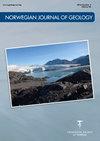求助PDF
{"title":"The deep geothermal potential of the radiogenic Løvstakken Granite in western Norway","authors":"M. Frey, J. Ebbing","doi":"10.17850/njg100-1-4","DOIUrl":null,"url":null,"abstract":"Frey, M. & Ebbing, J. 2020: The deep geothermal potential of the radiogenic Løvstakken Granite in western Norway. Norwegian Journal of Geology 100, 202004. https://dx.doi.org/10.17850/njg100-1-4. © Copyright the authors. This work is licensed under a Creative Commons Attribution 4.0 International License. We developed a first detailed 3D crustal model of the Bergen Region by combining geological information with gravity and magnetic data in order to estimate the geothermal potential of the Løvstakken Granite, which shows a particularly high concentration of radioactive elements. The geometry of the near-surface horizons in the model is consistent with geological observations and interpretations. The basement structure is, in contrast, associated with greater uncertainties due to the lack of land seismic or deep borehole data. To improve the geological model, we performed stochastic inversions of the gravity and magnetic fields resulting in three plausible models for the Løvstakken Granite. Based on these modelling results, the subsurface temperatures were predicted by numerical simulation and the various influencing factors were investigated, whilst the 516 m-deep Fyllingsdalen borehole provided important thermal constraints. Especially the radiogenic heat production affects the thermal structure of the crust in the Bergen Arcs and we show that the concentration of radioactive elements in the entire basement is on average 50% smaller than at the surface. The geometry of the Løvstakken Granite also influences the geothermal gradient, but the differences between the three crustal models of 3°C/km are rather moderate. Furthermore, a correction for the paleoclimatic conditions in western Norway is applied which has an effect of up to 7 ± 4°C. Lastly, the groundwater influence was determined by creating a coupled fluid flow and heat transport model. Local temperature changes of up to ± 5°C are found, but there is no significant cooling at the Fyllingsdalen borehole due to groundwater. According to the calculated geothermal gradient in the Bergen Arcs System, the potential for the generation of electricity is relatively low. In comparison, there is an intermediate potential for the extraction of heating energy, in particular in the urban area of Bergen.","PeriodicalId":49741,"journal":{"name":"Norwegian Journal of Geology","volume":" ","pages":""},"PeriodicalIF":0.8000,"publicationDate":"2020-06-18","publicationTypes":"Journal Article","fieldsOfStudy":null,"isOpenAccess":false,"openAccessPdf":"","citationCount":"3","resultStr":null,"platform":"Semanticscholar","paperid":null,"PeriodicalName":"Norwegian Journal of Geology","FirstCategoryId":"89","ListUrlMain":"https://doi.org/10.17850/njg100-1-4","RegionNum":4,"RegionCategory":"地球科学","ArticlePicture":[],"TitleCN":null,"AbstractTextCN":null,"PMCID":null,"EPubDate":"","PubModel":"","JCR":"Q2","JCRName":"Earth and Planetary Sciences","Score":null,"Total":0}
引用次数: 3
引用
批量引用
挪威西部放射性成因Løvstakken花岗岩深部地热潜力
Frey, M. & Ebbing, J. 2020:挪威西部Løvstakken花岗岩的深部地热潜力。地质学报100,2004。https://dx.doi.org/10.17850/njg100-1-4。©版权归作者所有。本作品采用知识共享署名4.0国际许可协议。结合地质信息和重磁数据,建立了卑尔根地区第一个详细的三维地壳模型,以估计Løvstakken花岗岩的地热潜力,该花岗岩显示出特别高的放射性元素浓度。模型中近地表层的几何形状与地质观测和解释一致。相比之下,由于缺乏陆地地震或深钻孔数据,基底结构具有更大的不确定性。为了改进地质模型,我们对Løvstakken花岗岩进行了重力和磁场的随机反演,得到了三个合理的模型。基于这些模拟结果,通过数值模拟对地下温度进行了预测,并研究了各种影响因素,其中516 m深的Fyllingsdalen钻孔提供了重要的热约束条件。特别是放射性生热作用影响了卑尔根弧的地壳热结构,表明整个基底的放射性元素浓度比地表平均低50%。Løvstakken花岗岩的几何形状也影响地温梯度,但3°C/km三种地壳模式之间的差异相当中等。此外,对挪威西部的古气候条件进行了校正,其影响可达7±4°C。最后,通过建立流体流动和热输运耦合模型来确定地下水的影响。发现当地温度变化高达±5°C,但由于地下水的影响,Fyllingsdalen钻孔没有明显的冷却。根据计算得到的卑尔根弧系地温梯度,其发电潜力相对较低。相比之下,特别是在卑尔根市区,采掘热能的潜力是中等的。
本文章由计算机程序翻译,如有差异,请以英文原文为准。


